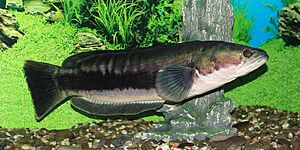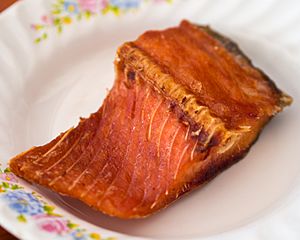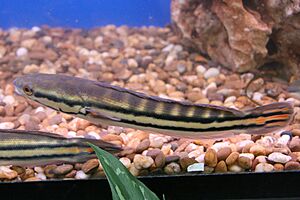Channa micropeltes facts for kids
Quick facts for kids Channa micropeltes |
|
|---|---|
 |
|
| Conservation status | |
| Scientific classification | |
| Synonyms | |
|
The Giant Snakehead (scientific name: Channa micropeltes) is a very large fish. It is one of the biggest fish in its family, Channidae. This amazing fish can grow up to 1.3 meters (about 4 feet) long. It can also weigh as much as 20 kilograms (about 44 pounds)!
This fish naturally lives in the fresh waters of Southeast Asia. However, it has also been moved to other places by people. In some areas, like Taiwan, it is considered an invasive species. This means it can cause problems for the local fish and environment. Other common names for this fish include red snakehead and giant mudfish.
Contents
Biology and Life Cycle
When Giant Snakeheads are young, they look very different. They are bright red with orange and black stripes on their sides. These stripes appear after about two months. Because of their color, young Giant Snakeheads are often called "red snakeheads."
As the Giant Snakehead gets older, its colors change. It loses its red color and stripes. Instead, its upper body becomes a mix of bluish-black and white.
This fish has a special ability: it can breathe air! It has a simple lung-like organ behind its gills. This helps it survive in water with low oxygen. It can come to the surface and gulp air. This special ability also lets it crawl onto land for short distances. It can only do this in muddy or swampy areas. This is why it's sometimes called a "mudfish." While on land, it cannot hunt because its fins are too small to support its large body.
Where Giant Snakeheads Live
The Giant Snakehead is found in Southeast Asia, including the Malay Peninsula and Indonesia. For a long time, people thought it also lived in southwest India. However, in 2011, scientists discovered that the fish in India is actually a separate species. It is now called C. diplogramma. So, Channa micropeltes only lives in Southeast Asia.
This fish is sometimes raised in ponds or cages. It can be helpful in controlling too many tilapia fish. This helps the tilapia grow better.
Giant Snakeheads as an Invasive Species
Sometimes, people release Giant Snakeheads into new places. This can happen when they are released from aquariums. When a species is introduced to a new area and causes harm, it is called an invasive species.
Giant Snakeheads have been reported in a few US states. These include Maine, Massachusetts, Tennessee, Wisconsin, Maryland, and Rhode Island. However, scientists do not believe they have created lasting populations there. This is different from their relative, the northern snakehead, which has established itself in some colder places.
In Maryland, a few Giant Snakeheads were caught in the early 2000s. In 2003, one was found in Rock River, Wisconsin. Scientists worried that warm water from factories might help these tropical fish survive in colder climates. But so far, there is no proof of them living and reproducing in the United States. Most catches are thought to be fish released from home aquariums.
In 2010, a dead Giant Snakehead was found in the Saint-Charles River in Quebec City, Canada. This was also likely a fish released from an aquarium.
The Giant Snakehead is well-established in Taiwan. It is considered an invasive species there, especially in Sun Moon Lake. People are trying to control them by fishing for the adult females before they lay eggs.
A Fishy Story
In 2005, a strange story came out of England. An angler (someone who fishes) claimed to have caught a Giant Snakehead in the River Witham in Lincolnshire. This story was very odd. The fish was supposedly caught in late winter. As a tropical fish, it would not be able to survive or even eat in a cold English river during winter. Later, it was found out that the story was a hoax. The fish had actually been found dead in a street, not caught alive.
Giant Snakeheads as Food

In countries like Malaysia, Singapore, and Indonesia, the Giant Snakehead is known as Toman. It is raised in fish ponds and reservoirs. People also like to catch it for sport because it fights hard when hooked. The Giant Snakehead is also good to eat. It is often served in Chinese restaurants.
In Thailand, this fish is cooked in many ways. Grilled Giant Snakehead is a common food sold by street vendors.
Some traditional beliefs suggest that eating this fish can help the body heal. For example, it is thought to help after surgery or bad cuts.
Giant Snakeheads as Pets
The Giant Snakehead is a popular fish in the fishkeeping hobby. It is often called the red or redline snakehead by pet owners. Young Giant Snakeheads are commonly sold as pets. Some are even sold as food for other large meat-eating fish.
These fish are very aggressive predators. They will chase and eat almost anything that fits into their mouths. Because of this, some people call them "freshwater great whites." However, they can sometimes live with other large fish. These include silver arowanas, clown knifefishes, and oscars, as long as they are about the same size.






